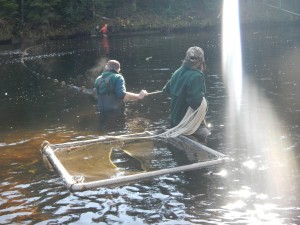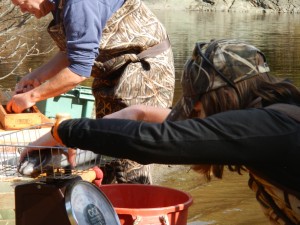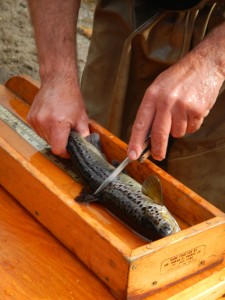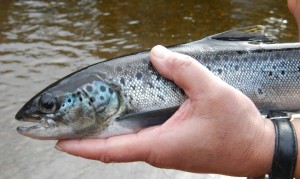October 24, 2012 at 9:00 am
[caption id="attachment_423" align="alignright" width="300"] Biologists dragging seine net through a section of the Kennebago River[/caption]
Seine netting is a non-lethal capture method employed by MDIFW fisheries biologists during the fall spawning season to monitor spawning fish populations in rivers. Fish are captured and given an anesthetic. Weights and lengths are measured, gender is determined and scales are taken for aging. Then the fish are released back into the water where they hang out sideways, waiting for the anesthetic to wear off, before swimming into deeper water.
A seine net is essentially a long, heavy-duty net with sides that funnel the fish down into a net ‘cage’ in the center of the net. The bottom side of the net is weighted so it sinks, the top side is floating. The net is stretched the width of the river being sampled, with at least two people on each end of the net. The net is walked a short ways down the river and the people with the end of the net on the opposite shore walk that end forward and around to form a large circled area with the net. Then the net is hauled in, capturing any fish within a certain depth (the depth of the net) that were residing in the area the net was dragged through. The fish are placed in a separate, large, square holding area of nets where they will await being measured. In small groups, the fish are transferred from the holding area to large buckets of water containing an anesthetic. As the fish respire the anesthetic, they become lethargic and easier to handle, making the whole process safer for the fish and the biologists. Fish are released back into the cold water of the river as soon as their measurements are taken. They typically recover from the anesthetic and swim away within 3-5 minutes.
[caption id="attachment_422" align="alignright" width="300"]
Biologists dragging seine net through a section of the Kennebago River[/caption]
Seine netting is a non-lethal capture method employed by MDIFW fisheries biologists during the fall spawning season to monitor spawning fish populations in rivers. Fish are captured and given an anesthetic. Weights and lengths are measured, gender is determined and scales are taken for aging. Then the fish are released back into the water where they hang out sideways, waiting for the anesthetic to wear off, before swimming into deeper water.
A seine net is essentially a long, heavy-duty net with sides that funnel the fish down into a net ‘cage’ in the center of the net. The bottom side of the net is weighted so it sinks, the top side is floating. The net is stretched the width of the river being sampled, with at least two people on each end of the net. The net is walked a short ways down the river and the people with the end of the net on the opposite shore walk that end forward and around to form a large circled area with the net. Then the net is hauled in, capturing any fish within a certain depth (the depth of the net) that were residing in the area the net was dragged through. The fish are placed in a separate, large, square holding area of nets where they will await being measured. In small groups, the fish are transferred from the holding area to large buckets of water containing an anesthetic. As the fish respire the anesthetic, they become lethargic and easier to handle, making the whole process safer for the fish and the biologists. Fish are released back into the cold water of the river as soon as their measurements are taken. They typically recover from the anesthetic and swim away within 3-5 minutes.
[caption id="attachment_422" align="alignright" width="300"] Two stations were set up where biologists could take length and weight measurements and collect scales from the fish caught.[/caption]
Biologists use this sampling technique on the Kennebago River in mid-October to assess growth conditions prevailing in Mooselookmeguntic Lake. The Kennebago River is the principal spawning area for landlocked salmon coming from Mooselookmeguntic Lake and by collecting biological data from these individuals in the principal spawning run biologists can determine how effectively the population is being managed in the lake. The size, age class, and general health (hooking injuries, parasites, and other notable markings) of these fish can be utilized in making recommendations regarding regulations to manage the available fishery at the highest quality possible for the health of that system.
In the two hours we were there, we caught and measured 146 landlocked salmon weighing between 3 ounces and 2 pounds 8 ounces and measuring between 8 and 20 inches in length and 13 brook trout weighing between 5 ounces and 1 pound 4.5 ounces and measuring between 10.5 and 15 inches in length. These individuals all looked very healthy and ready to spawn with minimal hooking injuries and no parasites observed. Mooselookmeguntic has a natural population of landlocked salmon that is not influenced by direct stocking. The overly large numbers of landlocked salmon in the population residing in the lake results in lots of small fish. For a population of larger, healthier individuals, the population requires some thinning, after all, there is only so much food and habitat to go around. For this reason, although we encourage catch and release on many lakes, ponds, and rivers in the state, MDIFW would like to encourage anglers to consider keeping and utilizing landlocked salmon of legal length and number caught from Mooselookmeguntic Lake.
[caption id="attachment_425" align="alignleft" width="225"]
Two stations were set up where biologists could take length and weight measurements and collect scales from the fish caught.[/caption]
Biologists use this sampling technique on the Kennebago River in mid-October to assess growth conditions prevailing in Mooselookmeguntic Lake. The Kennebago River is the principal spawning area for landlocked salmon coming from Mooselookmeguntic Lake and by collecting biological data from these individuals in the principal spawning run biologists can determine how effectively the population is being managed in the lake. The size, age class, and general health (hooking injuries, parasites, and other notable markings) of these fish can be utilized in making recommendations regarding regulations to manage the available fishery at the highest quality possible for the health of that system.
In the two hours we were there, we caught and measured 146 landlocked salmon weighing between 3 ounces and 2 pounds 8 ounces and measuring between 8 and 20 inches in length and 13 brook trout weighing between 5 ounces and 1 pound 4.5 ounces and measuring between 10.5 and 15 inches in length. These individuals all looked very healthy and ready to spawn with minimal hooking injuries and no parasites observed. Mooselookmeguntic has a natural population of landlocked salmon that is not influenced by direct stocking. The overly large numbers of landlocked salmon in the population residing in the lake results in lots of small fish. For a population of larger, healthier individuals, the population requires some thinning, after all, there is only so much food and habitat to go around. For this reason, although we encourage catch and release on many lakes, ponds, and rivers in the state, MDIFW would like to encourage anglers to consider keeping and utilizing landlocked salmon of legal length and number caught from Mooselookmeguntic Lake.
[caption id="attachment_425" align="alignleft" width="225"] A biologist takes scales from the fish to age the fish later on.[/caption]
[caption id="attachment_424" align="alignnone" width="300"]
A biologist takes scales from the fish to age the fish later on.[/caption]
[caption id="attachment_424" align="alignnone" width="300"] Landlocked salmon[/caption]
[embed]http://youtu.be/uasDTFXcJ7g[/embed]
Landlocked salmon[/caption]
[embed]http://youtu.be/uasDTFXcJ7g[/embed]
 Biologists dragging seine net through a section of the Kennebago River[/caption]
Seine netting is a non-lethal capture method employed by MDIFW fisheries biologists during the fall spawning season to monitor spawning fish populations in rivers. Fish are captured and given an anesthetic. Weights and lengths are measured, gender is determined and scales are taken for aging. Then the fish are released back into the water where they hang out sideways, waiting for the anesthetic to wear off, before swimming into deeper water.
A seine net is essentially a long, heavy-duty net with sides that funnel the fish down into a net ‘cage’ in the center of the net. The bottom side of the net is weighted so it sinks, the top side is floating. The net is stretched the width of the river being sampled, with at least two people on each end of the net. The net is walked a short ways down the river and the people with the end of the net on the opposite shore walk that end forward and around to form a large circled area with the net. Then the net is hauled in, capturing any fish within a certain depth (the depth of the net) that were residing in the area the net was dragged through. The fish are placed in a separate, large, square holding area of nets where they will await being measured. In small groups, the fish are transferred from the holding area to large buckets of water containing an anesthetic. As the fish respire the anesthetic, they become lethargic and easier to handle, making the whole process safer for the fish and the biologists. Fish are released back into the cold water of the river as soon as their measurements are taken. They typically recover from the anesthetic and swim away within 3-5 minutes.
[caption id="attachment_422" align="alignright" width="300"]
Biologists dragging seine net through a section of the Kennebago River[/caption]
Seine netting is a non-lethal capture method employed by MDIFW fisheries biologists during the fall spawning season to monitor spawning fish populations in rivers. Fish are captured and given an anesthetic. Weights and lengths are measured, gender is determined and scales are taken for aging. Then the fish are released back into the water where they hang out sideways, waiting for the anesthetic to wear off, before swimming into deeper water.
A seine net is essentially a long, heavy-duty net with sides that funnel the fish down into a net ‘cage’ in the center of the net. The bottom side of the net is weighted so it sinks, the top side is floating. The net is stretched the width of the river being sampled, with at least two people on each end of the net. The net is walked a short ways down the river and the people with the end of the net on the opposite shore walk that end forward and around to form a large circled area with the net. Then the net is hauled in, capturing any fish within a certain depth (the depth of the net) that were residing in the area the net was dragged through. The fish are placed in a separate, large, square holding area of nets where they will await being measured. In small groups, the fish are transferred from the holding area to large buckets of water containing an anesthetic. As the fish respire the anesthetic, they become lethargic and easier to handle, making the whole process safer for the fish and the biologists. Fish are released back into the cold water of the river as soon as their measurements are taken. They typically recover from the anesthetic and swim away within 3-5 minutes.
[caption id="attachment_422" align="alignright" width="300"] Two stations were set up where biologists could take length and weight measurements and collect scales from the fish caught.[/caption]
Biologists use this sampling technique on the Kennebago River in mid-October to assess growth conditions prevailing in Mooselookmeguntic Lake. The Kennebago River is the principal spawning area for landlocked salmon coming from Mooselookmeguntic Lake and by collecting biological data from these individuals in the principal spawning run biologists can determine how effectively the population is being managed in the lake. The size, age class, and general health (hooking injuries, parasites, and other notable markings) of these fish can be utilized in making recommendations regarding regulations to manage the available fishery at the highest quality possible for the health of that system.
In the two hours we were there, we caught and measured 146 landlocked salmon weighing between 3 ounces and 2 pounds 8 ounces and measuring between 8 and 20 inches in length and 13 brook trout weighing between 5 ounces and 1 pound 4.5 ounces and measuring between 10.5 and 15 inches in length. These individuals all looked very healthy and ready to spawn with minimal hooking injuries and no parasites observed. Mooselookmeguntic has a natural population of landlocked salmon that is not influenced by direct stocking. The overly large numbers of landlocked salmon in the population residing in the lake results in lots of small fish. For a population of larger, healthier individuals, the population requires some thinning, after all, there is only so much food and habitat to go around. For this reason, although we encourage catch and release on many lakes, ponds, and rivers in the state, MDIFW would like to encourage anglers to consider keeping and utilizing landlocked salmon of legal length and number caught from Mooselookmeguntic Lake.
[caption id="attachment_425" align="alignleft" width="225"]
Two stations were set up where biologists could take length and weight measurements and collect scales from the fish caught.[/caption]
Biologists use this sampling technique on the Kennebago River in mid-October to assess growth conditions prevailing in Mooselookmeguntic Lake. The Kennebago River is the principal spawning area for landlocked salmon coming from Mooselookmeguntic Lake and by collecting biological data from these individuals in the principal spawning run biologists can determine how effectively the population is being managed in the lake. The size, age class, and general health (hooking injuries, parasites, and other notable markings) of these fish can be utilized in making recommendations regarding regulations to manage the available fishery at the highest quality possible for the health of that system.
In the two hours we were there, we caught and measured 146 landlocked salmon weighing between 3 ounces and 2 pounds 8 ounces and measuring between 8 and 20 inches in length and 13 brook trout weighing between 5 ounces and 1 pound 4.5 ounces and measuring between 10.5 and 15 inches in length. These individuals all looked very healthy and ready to spawn with minimal hooking injuries and no parasites observed. Mooselookmeguntic has a natural population of landlocked salmon that is not influenced by direct stocking. The overly large numbers of landlocked salmon in the population residing in the lake results in lots of small fish. For a population of larger, healthier individuals, the population requires some thinning, after all, there is only so much food and habitat to go around. For this reason, although we encourage catch and release on many lakes, ponds, and rivers in the state, MDIFW would like to encourage anglers to consider keeping and utilizing landlocked salmon of legal length and number caught from Mooselookmeguntic Lake.
[caption id="attachment_425" align="alignleft" width="225"] A biologist takes scales from the fish to age the fish later on.[/caption]
[caption id="attachment_424" align="alignnone" width="300"]
A biologist takes scales from the fish to age the fish later on.[/caption]
[caption id="attachment_424" align="alignnone" width="300"] Landlocked salmon[/caption]
[embed]http://youtu.be/uasDTFXcJ7g[/embed]
Landlocked salmon[/caption]
[embed]http://youtu.be/uasDTFXcJ7g[/embed]
Categories